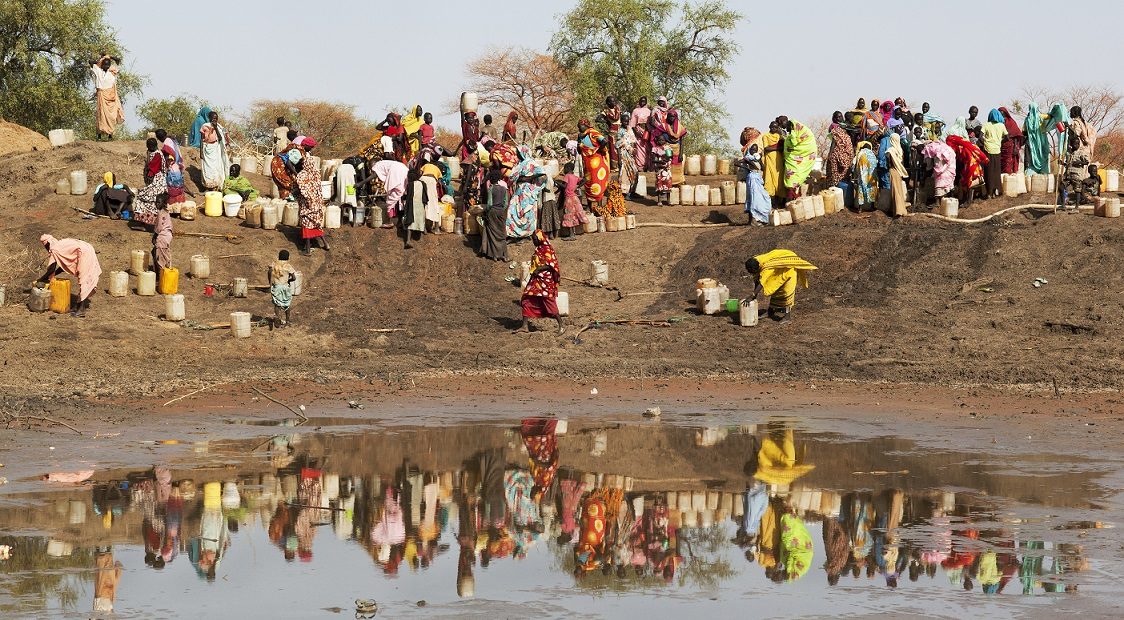Bushfires in Australia, cyclones in the Bahamas, lethal ‘dzud’ winters in Mongolia, floods in Eastern Africa… We witness daily confirmations that climate change is not only an anxiety-inducing risk to our collective future, but a generator of humanitarian consequences that, as you read this very line, wreak havoc in the lives of millions of women, men, children and older people across the globe.
In this decade alone, climate-related disasters can be expected to increase by half the number of people in need of international humanitarian aid. By 2030, more than 150 million people may have to rely on a humanitarian system that is already reaching its limits today. By 2050, this total could be 200 million people each year.
These are the sobering findings of our report last September, “The Cost of Doing Nothing,” wherein the International Federation of Red Cross and Red Crescent Societies (IFRC), using World Bank methodology to project levels of poverty and population growth, assessed the likely current and future costs of the humanitarian response to climate-related crises and then mapped them against likely climate-related humanitarian crises.
These figures, already alarming, are actually quite conservative; they exclude anyone with access to more than ten US dollars per day from the calculation of people potentially requiring aid and look only to the costs of international humanitarian assistance. Yet, they show that the immense human toll of climate change will also come with a huge financial price tag. The cost of providing aid to people affected by floods, storms, droughts and wildfires is expected to balloon to 20 billion US dollars a year by 2030 – nearly doubling today’s financial needs.
A disproportionate impact on the poorest
The people suffering most from the climate crisis are the world’s poorest, such as marginalized groups who live in areas where floods, droughts and storms are hitting the hardest, and who are also ill-equipped to access sustainable solutions like rebuilding more solidly or moving to safer areas. Disasters reinforce and perpetuate existing inequalities, weaken social protection mechanisms and increase the risk of sexual and gender-based violence.
In agriculture-based economies, pressure on women deepens as the climate becomes more unpredictable with changing temperatures. Extreme conditions and disasters exacerbate their already scarce economic resources, lack of access to land ownership and education, and threats to their physical integrity and safety, creating a toxic cocktail for women and girls, as well as for others, such as disabled or older people and sexual and gender minorities.
For example, a recent IUCN report found evidence that human trafficking, transactional sex, and sexual- and gender-based violence all increase in direct connection with the tensions over resources that climate crisis induces. There are ways to improve laws and policy on gender equality and protection from sexual- and gender-based violence in disasters, as outlined in an IFRC study that examined case studies from Ecuador, Nepal and Zimbabwe. We need to do much more to understand and ensure we meet the different needs of different people facing a variety of barriers to protection, and that our efforts are informed by the diversity of their perspectives.
Working today to reduce risks
The IFRC network, with 192 member National Red Cross and Red Crescent Societies, assembling some 14 million volunteers on the ground, is committed to scaling up its own climate action, globally. For many years, it has capitalized on its presence before, during and after emergencies to be active ahead of disasters, supporting adaptation to climate and weather-related events through disaster risk reduction efforts. This is about taking preventative measures to reduce communities’ vulnerabilities to climate and weather-related shocks, tailoring solutions to local circumstances.
In the last ten years, disaster risk reduction investments by the IFRC network have more than quadrupled to 207 million Swiss Francs in 2018, reaching 52 million people in 160 countries. Today, the IFRC network is clearly one of the biggest disaster risk reduction actors in the world and a key player in the implementation of the Sendai Framework for Disaster Risk Reduction, the flagship international instrument in this area. The IFRC also works with States to develop and improve their disaster laws, supporting public authorities so that their regulatory frameworks guide disaster risk management and climate change adaptation, addressing climate risks and the needs of the most vulnerable. Recently, in December 2019, during the latest International Conference of the Red Cross and Red Crescent, the State Parties to the Geneva Conventions and the 192 Red Cross/Red Crescent National Societies unanimously adopted a resolution affirming their commitment to “disaster laws and policies that leave no one behind,” and recognizing the importance of integrating protection and inclusion of vulnerable groups into relevant disaster laws and policies.
The target for 2020 is to double the reach of IFRC’s disaster risk reduction and climate change adaptation programming to make 100 million people safer. This is a massive endeavor, yet we are acutely aware that a sheer increase of current activities is not enough.
‘Climate-smart’ programming – getting ahead of the curve
The IFRC network strives to ensure ‘climate-smart’ programming: programs designed to consider historic risks as well as future and anticipated climate risks, informed by climate science. Being climate-smart means enabling people to anticipate, absorb and adapt to climate shocks and stresses by using climate information across timescales, considering landscapes and ecosystems as key areas of intervention. Practically, this means taking action ahead of the impact of weather extreme events and ensuring people are kept safe from harm, rather than afterwards, through a standard humanitarian response.
The recent activation of the anticipatory action funding mechanism through IFRC’s Disaster Relief Emergency Fund to support vulnerable herder families expected to be impacted by extreme winter in Mongolia serves as a good example of how the use of climate and weather data ahead of a predicted disaster can alleviate human suffering.
Scaling up the IFRC’s climate action goes hand in hand with increased engagement with other actors committed to addressing the climate crisis. Too often, the climate, humanitarian and development communities work in silos when trying to adapt to the same rising risks of climate change. This urgently needs to change.
The Risk-Informed Early Action Partnership (REAP) aims to reverse this trend. Launched at the UN Climate Action Summit in September 2019, REAP brings together over 25 diverse partners to coordinate and bring to scale measures designed to protect people at greatest risk of climate-related disasters. IFRC has supported the design and development of this partnership and is committed to its implementation to ensure that investment in early warning and early action reaches the most vulnerable.
An urgent call for scaled up action
Scaling up climate adaptation and disaster risk reduction is urgent and requires massive and coordinated efforts. Currently, most communities have next to no access to climate finance for adaptation activities. Development efforts too rarely encompass adequate preparation for the new risks brought on by the changing climate. Governments, funders and responders have yet to make full use of predictive science to take action at the community level in time, before extreme events strike.
Many steps are being taken to address and adapt to climate risks, but doing a little better will not be good enough. We must do more – with more speed, more effectively, more partners, and at a much greater scale. We need to harness local ideas and innovations, and scale them up globally. Many women and girls are at the frontlines; they have taken many important initiatives already improving lives and livelihoods and increasing climate resilience around the world. We must recognize that expertise and encourage and support homegrown projects that are leading the way towards more equitable and sustainable solutions to climate change.
The climate crisis is not only about the future of our planet. It is an ongoing humanitarian crisis, with lives and livelihoods already on the line. Now is the time to scale up climate mitigation and adaptation measures to alleviate the ongoing and future humanitarian consequences of the climate crisis.
See also
- Catherine-Lune Grayson, When rain turns to dust: climate change, conflict and humanitarian action, December 5, 2019
- Helen Durham & Kosuke Onishi, ‘Act today, shape tomorrow’: the 33rd International Conference, December 10, 2019






¡Hola!
Excelente,articulo
Es preocupante saber que pese a los esfuerzos,subsisten los daños y muchos riezgos de daños ambientales que afecta no solo la salud,si no la vida de los seres vivos incluyendonos a nosotros,los humanos, pero estamos a tiempo,todos podemos aportar un poco , para que el futuro sea mejor. Este año plantare arboles y arrojaremos en familia,semillas por todos los sitios a donde vamos y sea posible,para que los arboles que crezcan ayuden a purificar el aire. Se que no es mucho,pero por algo se empieza.
Los felicito por tan linda labor, saludos desde Medellin Combia..
Atentamente
Nancy
Hola Nancy, ¡gracias por compartir tus ideas y por tu contribucion!
Well narrated blog post. While I agree to many facts presented herein, still, I am of the opinion that efforts, initiatives, projects and programmes to prepare and address for climate change adaptation are still more theoretical than practical – this need to change, but how?
Let us consider a case in my country Tanzania, poorest and marginalized people and communities live in valleys, waterways, poor served areas – all these are highly risk areas when it comes to extreme weather events – floods in particular.
As early as this February – some areas in Tanzania were heavily affected by heavy floods – Lindi and Mwanza regions to mention few.
As a personal opinion, I think it would be a better strategy to avoid humanitarian crises induced by climate change if for example, Stay-off highly risk areas. What I mean here is that, all areas prone to severe weather events should be declared unfit for living and livelihoods. Areas like valleys, waterways, steep slopes and the alike – should be red flagged as hazardous areas for human survival. Some countries like mine (Tanzania) still have huge chunk of unoccupied land and leveraging on this potential would save lives of many if not all members of the marginalized groups.
Finally – there are so many hidden ideas to curb effects of climate change. Those ideas are with people who never get opportunities to working with international humanitarian agencies like IRC, IFRC, and others – just because we lack experience working with international NGOs, etc. This also need to change and people who have innovation and creativity should be given chance to showcase the abilities but most importantly to help addressing this frightening humanitarian crisis exacerbated by unpredictable climate change.
Hi Godfrey, and thanks very much for the thoughtful reflection. Indeed, as Cécile mentions, there are many local and grassroots initiatives that need to be showcased and simulated. Do you know of any leaders in your region working to curb the humanitarian crisis caused by climate change who could be interested in contributing to the blog? Thanks for reading!